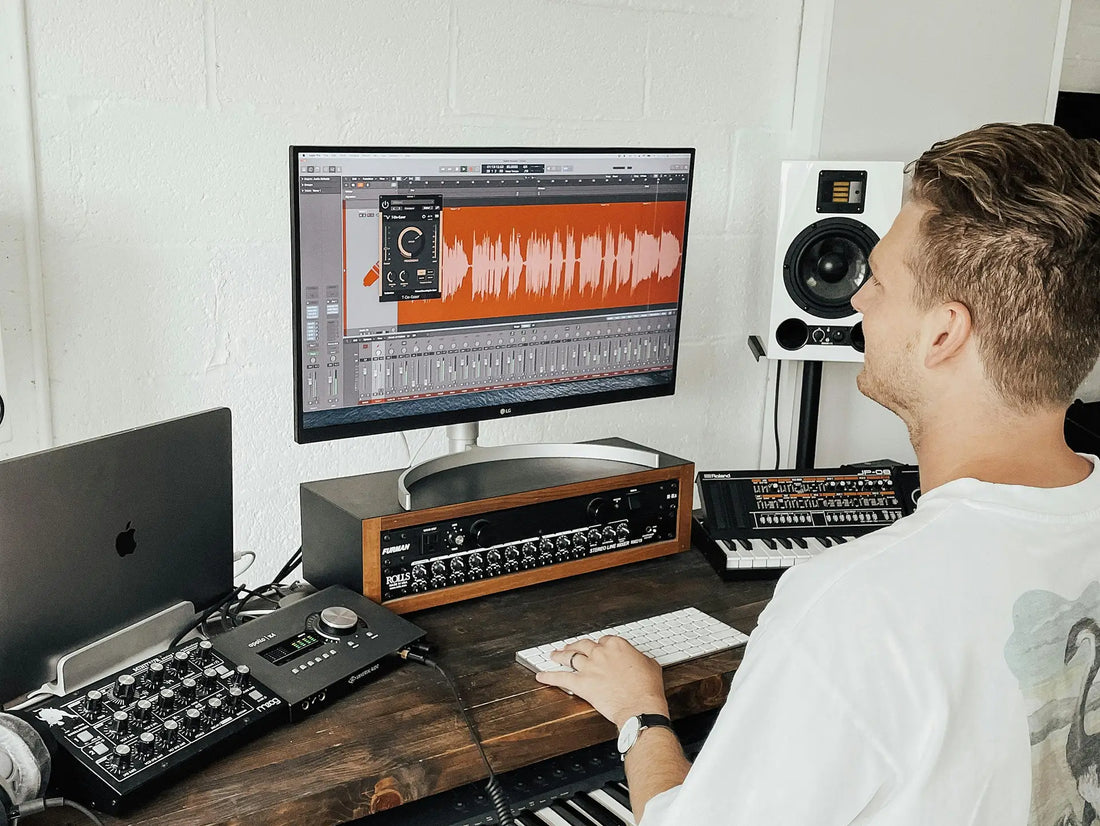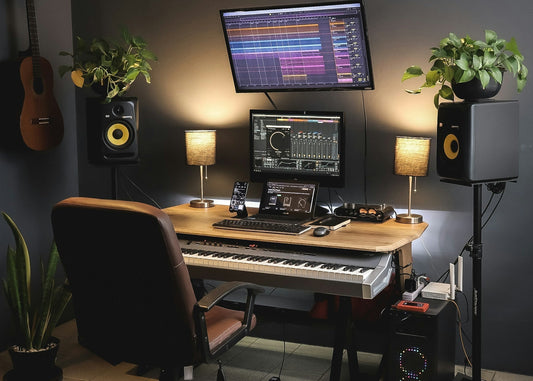
The Complete Beginner's Guide to Home Studio Acoustic Treatment
Share
James, founder of AudioSilk here, and welcome to the blog!
I remember when I first started recording in my tiny flat in London. I had saved for months to buy decent gear—a solid interface, a nice mic, and some entry-level monitors.
I was so excited to start creating, but when I played back my first recordings... they sounded nothing like I expected.
The vocals were muddy, the mix was boomy in some places and thin in others, and everything I created sounded completely different when I played it in my car or on headphones.
Sound familiar?
What I discovered (the hard way) is something that professional engineers have known forever: the room you record in matters just as much as the gear you use.
It's the space, the setup, and how you create and curate your studio environment that can make such a difference in your sound quality. It's all about managing the vibrations and having them create the best possible sound.
How you do this is a process known as acoustic treatment, and today, I want to walk you through everything I've learned without the complex jargon or assuming you've got thousands to spend.
Why your home music studio room is lying to you
When sound comes out of your speakers or instrument, it doesn't just travel directly to your ears.
It bounces around your room, creating reflections that reach your ears at slightly different times. Of course, your brain processes all of this as one sound (it would be crazy any other way)—but a distorted version of what you should be hearing.

Research shows that the difference between treated and untreated rooms is pretty substantial. Untreated rooms have up to 60 dB of sound variation in high tones and 41 dB in the low tones, which is shocking when you really think about it.
The most common issues in untreated rooms include:
- Room modes - These are spots where specific frequencies get artificially boosted or cancelled, making some notes boom while others disappear
- Early reflections - Sound bouncing off side walls, ceiling, and floor that muddy the stereo image
- Flutter echoes - That "ping-pong" effect you hear when you clap in an empty room, which masks detail in your recordings
- Speaker boundary issues - Problems that occur when monitors are placed too close to walls, creating unpredictable bass response
The best way to think of this is to imagine two empty rooms. One has carpet and one has a hard floor. Shout into both rooms, and what happens?
The carpet absorbs the sound and muffles the echo. The hardwood bounces it around. Control this and you control your audio quality.
This one of the reasons why when you mix at home in your room and get it sounding great, but play the same track in the car, it sounds completely different.
Treatment vs. soundproofing (they are not the same thing!)

Before we dive deeper, let's clear up a common misconception. Acoustic treatment is NOT the same as soundproofing.
Soundproofing stops sound from entering or leaving a room. It generally requires heavy construction—double walls, floating floors, and solid doors. It's expensive and involves significant building work.
On the other hand, acoustic treatment improves sound quality within your room by controlling reflections and resonances. It's about making your room sound better, not preventing sound from escaping.
Those foam panels you see on YouTube?
They're for treatment, not soundproofing (no matter what some manufacturers might claim!). They won't stop your neighbours from hearing your 2am drum session. So bear that in mind.
The essential tools for taming the sound of your room
Right, let's look at the main components of effective acoustic treatment:
Absorption panels
These panels absorb sound energy, reducing reflections. The most effective ones are made from PET, mineral wool or fiberglass.
While those egg-crate foam panels you see online might look the part, they're honestly not very effective. Proper absorption panels address a much wider frequency range.
At AudioSilk, we've created panels that combine proper acoustic performance with designs that won't make your room look like a recording booth. Because let's be honest—we often record in living spaces that we share with others.
Bass traps
If there's one thing I wish someone had told me when I started out: it's that low frequencies are the hardest to control in small rooms.
Bass traps are thicker absorbers (typically 4-6 inches) that target lower frequencies. They're most effective when placed in corners where bass energy concentrates. Even just a couple of bass traps can dramatically clean up the mud in your mixes and recordings.
Not every user will need bass traps. For many applications they can be overkill, e.g. vocal recording for music/podcasts/YouTube, basic instrument recording, rehearsal spaces. But for serious mixing and recording studio projects they will often be required in order to get a flat frequency response.
If you have a limited budget, start with some acoustic panels. This will make the biggest immediate difference to clarity and detail. If you then find that your room has significant issues in the low end, or that you are ready to upgrade, add some bass traps.
Diffusers
While absorption removes energy from the room, diffusers scatter sound in multiple directions. This prevents strong reflections while maintaining a sense of space and liveliness.
In smaller home studios (under 150 square feet), absorption should be your primary focus. But in medium to larger rooms, combining absorption with some diffusion creates a more natural, balanced sound.
Fun fact: a well-filled bookshelf actually makes a pretty decent diffuser! This is why some rooms with lots of books just naturally sound good.
Where to place your acoustic treatment panels
This does vary a lot depending on the size of the room and the intended usage. We have a detailed article here, which covers different room types and usages. But for now, let's take a basic example of a small bedroom listening/mixing/recording room:
We'll still be using the panel form of acoustic treatment because it's by far the easiest to set up and start using. However, strategic placement is still everything when it comes to acoustic treatment. Here's where to focus first:
First reflection points
These are the spots where sound from your speakers bounces off walls before reaching your ears. Treating these points has an immediate, dramatic effect on clarity and stereo imaging.
To find them, sit in your listening position and have a friend slide a mirror along the side walls. When you can see your speakers in the mirror, that's a first reflection point that needs absorption.
Don't forget about the ceiling reflection point above your listening position—it can also cause issues and may need to be treated.
Corner bass trapping
Corners are where bass energy builds up most significantly. Even if you can only manage two bass traps in the corners behind your listening position, you'll hear a significant improvement.
Coverage guidelines
You don't need to cover every inch of your walls! For most rooms, treating about 40-60% of your wall surface area creates a good balance without making the room sound unnaturally dead.
The goal is to control problematic reflections while maintaining some natural ambience. A completely dead room isn't pleasant to work in either!
Budget-friendly acoustic treatment approaches that actually work
AudioSilk began because I was frustrated by the lack of affordable, effective acoustic treatment options. But even if you're on an extremely tight budget, there are still ways to improve your room:
The £0-100 approach
- Use what you already have: Bookshelves, soft furnishings, and thick curtains all help
- Rearrange your setup: Position monitors away from walls, avoid room corners for your listening position
- DIY with moving blankets: Not perfect, but better than nothing for temporary treatment
The £100-300 sweet spot
With this budget, focus on:
- 4 - 8 acoustic panels for first reflection points
- 2 - 4 bass traps for corners
- Ceiling panels above your listening position, if necessary
This strategic placement of a few quality elements will deliver something in the region of 70-80% of the benefit of a fully-treated room.
Commercial/high end - £500-£5000+
If you’re running a commercial studio or have the budget for a premium setup, professional-grade acoustic treatment is absolutely worth considering. Custom-designed rooms, full-spectrum absorption, and detailed tuning can take your sound to the highest level.
Some companies offer 3D acoustic modelling and tailored treatment plans based on your room’s dimensions and usage. If it's within your budget, we highly recommend exploring this route — many of the same products used in world-class studios like Abbey Road can be installed in home environments, delivering equally outstanding results.
That said, we recognise that today’s home creators don’t always need a four-figure setup. Thanks to modern recording software and smart treatment choices, it's possible to achieve professional sound without professional prices.
That’s where AudioSilk comes in — we're here for the new generation of bedroom producers, content creators, and musicians who want real acoustic performance on a realistic budget.
What are the real results you can expect?
When you properly treat your room, even modestly, here's what happens:
- Your frequency response smooths out: Those boomy spots and missing notes even out, giving you a more accurate picture of your mix
- Stereo imaging improves dramatically: You'll hear precise placement of instruments and effects in the stereo field
- Mix translation gets better: What sounds good in your room will finally sound good on other systems, too.
- Recordings sound cleaner and more professional: Less room colouration means your raw recordings need less processing to sound great
- You work faster: With increased monitoring confidence, you'll make decisions more quickly and second-guess yourself less
Many customers report that acoustic treatment was a bigger upgrade to their sound than buying expensive new gear. As one client told me, "I finally hear what my mixes actually sound like, not what my room was doing to them."
What are the common mistakes to avoid?
Through years of helping home studio owners, I've seen some common mistakes worth mentioning:
- Using only foam products: These don't address a wide enough frequency range and are generally quite low quality.
- Ignoring bass issues: plenty of issues can occur below 300Hz, where bass builds up and cancels out
- Placing monitors incorrectly: Even perfect acoustic treatment can't fix poorly positioned speakers
- Creating asymmetrical treatment: Your left and right sides should have similar treatment for balanced sound
- Over-absorbing the room: Too much absorption creates an unnaturally dead space that's unpleasant to work in
Beyond panels: Other ways to improve your studio sound
We always recommend using an acoustic treatment plan as the foundation of good studio room treatment. However, there are several other approaches that can take your studio sound to the next level.
Bring all these together, and you'll have a professional home studio setup that delivers quality sound pretty much from now on.
Monitor isolation
Your monitors transfer vibrations to whatever surface they're sitting on—whether a desk, stands, or shelves. These vibrations can colour your sound and create resonances that mask what you're actually hearing.
Isolation pads or stands are an affordable solution that can make a surprising difference. They decouple your monitors from the surface, reducing unwanted vibrations and allowing you to hear a cleaner, more accurate sound.
For around £20-30, these pads can provide an immediate improvement in clarity and definition.
Digital room correction
Even with physical acoustic treatment, most rooms still have a few problem frequencies that can't be completely ironed out. To cover this, you can use digital room correction software that analyses your room's acoustic signature and applies corrective EQ to compensate.
Options like Sonarworks Reference, IK Multimedia ARC, or the free Room EQ Wizard paired with Equalizer APO can measure your room's response and create a custom correction profile for your listening position.
While this isn't a replacement for physical treatment (especially for recording), it works brilliantly as a complementary solution, handling more minor issues that physical treatment might miss.
It might even be ideal if you're just looking to see how much of a difference acoustic treatment can make.
Speaker placement optimization
Before spending a penny on treatment, make sure your monitors are correctly positioned, and it can dramatically improve what you're hearing:
- Position speakers to form an equilateral triangle with your listening position
- Align tweeters at ear level
- Place monitors at least 8 inches from walls to reduce boundary effects
- Ensure symmetrical placement relative to side walls
- Avoid placing monitors in corners where bass builds up
Even a few inches of adjustment can make a noticeable difference in clarity and stereo imaging. We often recommend spending a day experimenting with different positions before finalizing your acoustic treatment plan.
Avoid parallel surfaces
Parallel walls create standing waves and flutter echoes—those ping-pong reflections that colour your sound. While not everyone can rebuild their walls at angles, there are simpler approaches:
- Position your desk and gear at non-parallel angles to the room
- Use bookshelves or storage units to break up flat wall surfaces
- Hang artwork or panels at a slight angle rather than flat against walls
- Consider adjustable angled panels that can be tilted to reduce parallelism
Even small adjustments to create non-parallel surfaces can significantly reduce problematic reflections.
Control background noise
Often overlooked, but absolutely critical—minimizing background noise helps you hear subtle details in your mix:
- Use weatherstripping or door sweeps to seal gaps around doors
- Place noisy equipment (computers, hard drives) away from your listening position
- Consider a separate machine room for particularly loud gear, if possible
- Use quieter fans in your computer or invest in a quieter PC build
- Schedule recording sessions during quieter periods
The lower your noise floor, the more accurately you'll hear the details in your recordings and mixes.
Use regular recalibration and testing
Your studio is a living environment that changes over time.
Seasonal changes affect humidity and temperature, influencing how sound behaves in your room. Equipment gets moved, furniture changes, and gradually your carefully-tuned space drifts.
Set a calendar reminder to re-test your room's response quarterly. Use tools like:
- A measurement microphone and Room EQ Wizard for frequency response
- Reference tracks you know intimately to check translation
- Simple clap tests to identify new flutter echoes
- Pink noise to check for frequency balance
This regular maintenance ensures your space continues performing at its best.
The right headphones as a reference
Even in a well-treated room, having a high-quality pair of reference headphones provides an important alternative perspective. Look for headphones known for accuracy rather than hyped bass or treble.
Open-back models like the Sennheiser HD600 series or Beyerdynamic DT880s offer relatively flat response for checking details that your room might still mask.
Remember, headphones aren't a replacement for monitors in a treated room—they're a complementary tool that gives you another reference point.
Taking the first steps
Bringing all this together, here's a simple action plan to help you transform your room:
- Start with the basics: Optimize your speaker and listening position placement
- Control early reflections: Treat first reflection points on side walls and ceiling
- Address bass issues: Add corner bass traps where possible
- Balance with some diffusion: In larger rooms, add some diffusion on the rear wall
- Test and adjust: Listen to familiar reference tracks and adjust as needed
Remember, you don't have to do everything at once. Start with the most critical elements and build from there as your budget allows. Even modest treatment following these principles will dramatically improve your recordings and mixes.
Why it all matters
I started AudioSilk because I believe everyone deserves the chance to hear their music clearly, without their room getting in the way. You might have the talent, the ideas, and even decent gear—but if you can't hear accurately what you're creating, it's like trying to paint in a room with distorted mirrors.
The good news?
Acoustic treatment doesn't have to be complicated or prohibitively expensive. With some strategic planning and the right approach, you can transform your space into one that reveals rather than colours your sound.
We'd love to hear about your room treatment journey! Drop us a message if you have questions or want to share your before-and-after experiences.
Here's to better sound,
James, Founder & CEO, AudioSilk
P.S. For readers of this guide, use code BLOG10 for 10% off your first AudioSilk panel order. And we'd love to see your setup once your panels are installed – tag us on Instagram @audiosilkco to show off your transformed space!




